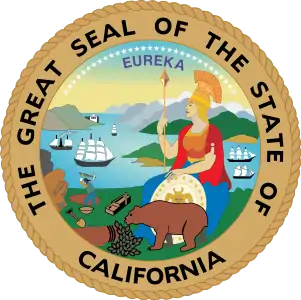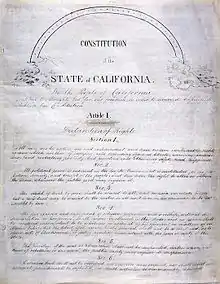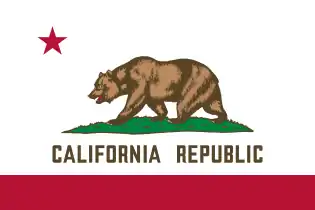Politics of California
The recent and current politics of the U.S. state of California are complex and involve a number of entrenched interests. (For historical politics, see Politics of California before 1900).
 |
|---|
| This article is part of a series on the politics and government of California |
|
Government

.jpg.webp)
The Big Five is an informal institution of the legislative leadership role in California's government, consisting of the governor, the Assembly speaker, the Assembly minority leader, the Senate president pro tempore, and the Senate minority leader. Members of the Big Five meet in private to discuss bills pending in the legislature. Because the party caucus leaders in California's legislature also control the party's legislative campaign funds, the leaders wield tremendous power over their caucus members. They are thus able to exert some influence in their caucus's votes in Big Five meetings.
Electoral system
Only the Democratic Party and Republican Party currently have representation in the State Legislature. However, for a brief period around the turn of the 21st century, one member of the Green Party was a member of the State Assembly, representing the eastern San Francisco Bay Area.
California currently uses the non partisan blanket primary in its elections, where candidates regardless of party, including multiple nominees from a single party, contest the ballot and the candidates with the two highest numbers of votes are entered into a general election, but some municipalities such as San Francisco and Berkeley have opted to use a system of preferential voting, currently used in Australia and Ireland, more popularly known in the United States as instant-runoff voting or ranked choice voting.
Local elections in California at the county and city level are officially non-partisan and political party affiliations are not included on local election ballots, and if one candidate fails to have a majority on the first ballot, a runoff between the two highest scoring candidates occurs.
Electoral history
The first presidential election the state participated in was 1852 in which it was carried easily by Democrat Franklin Pierce. From the Civil War onward, California was a reliably Republican stronghold for decades. Beginning with the 1932 election, the state shifted into the Democratic camp. Franklin Roosevelt carried all but one county in the state in 1932, and in 1936 all counties. Roosevelt's third and fourth presidential elections saw him win by smaller margins. The 1952 election saw California shift back to a red state as Dwight Eisenhower carried all but three counties. Aside from 1964, California was a reliably Republican state in every presidential election until 1992, when it was carried by Bill Clinton. The state has voted Democratic in every presidential election since then, usually by lopsided margins. Voting patterns since 1992 have remained consistent, with Democratic presidential candidates carrying the coastal counties and Republicans the inland counties.
At the state level, California has had more mixed voting tendencies. Six of the state's first seven governors were Democrats; during subsequent decades, control of the governorship frequently shifted between the two parties. From 1899 to 1939, almost all governors were Republican, but since that time the governorship has switched parties regularly.
Political parties
| Year | Republican | Democratic | Others |
|---|---|---|---|
| 2020 | 34.32% 6,006,429 |
63.48% 11,110,250 |
2.20% 384,202 |
| 2016 | 31.49% 4,483,810 |
61.48% 8,753,788 |
7.03% 1,000,286 |
| 2012 | 37.12% 4,839,958 |
60.24% 7,854,285 |
2.77% 361,572 |
| 2008 | 36.91% 5,011,781 |
60.94% 8,274,473 |
2.19% 296,829 |
| 2004 | 44.36% 5,509,826 |
54.40% 6,745,485 |
1.34% 166,548 |
| 2000 | 41.65% 4,567,429 |
53.45% 5,861,203 |
4.90% 537,224 |
| 1996 | 38.21% 3,828,380 |
51.10% 5,119,835 |
10.69% 1,071,269 |
| 1992 | 32.61% 3,630,574 |
46.01% 5,121,325 |
21.38% 2,379,822 |
| 1988 | 51.13% 5,054,917 |
47.56% 4,702,233 |
1.31% 129,914 |
| 1984 | 57.51% 5,467,009 |
41.27% 3,922,519 |
1.22% 115,895 |
| 1980 | 52.69% 4,524,858 |
35.91% 3,083,661 |
11.40% 978,544 |
| 1976 | 49.35% 3,882,244 |
47.57% 3,742,284 |
3.08% 242,589 |
| 1972 | 55.01% 4,602,096 |
41.54% 3,475,847 |
3.46% 289,919 |
| 1968 | 47.82% 3,467,664 |
44.74% 3,244,318 |
7.44% 539,605 |
| 1964 | 40.79% 2,879,108 |
59.11% 4,171,877 |
0.09% 6,601 |
| 1960 | 50.10% 3,259,722 |
49.55% 3,224,099 |
0.35% 22,757 |
| 1956 | 55.39% 3,027,668 |
44.27% 2,420,135 |
0.34% 18,552 |
| 1952 | 56.83% 3,035,587 |
42.27% 2,257,646 |
0.91% 48,370 |
| 1948 | 47.13% 1,895,269 |
47.57% 1,913,134 |
5.30% 213,135 |
| 1944 | 42.97% 1,512,965 |
56.48% 1,988,564 |
0.55% 19,346 |
| 1940 | 41.34% 1,351,419 |
57.44% 1,877,618 |
1.22% 39,754 |
| 1936 | 31.70% 836,431 |
66.95% 1,766,836 |
1.35% 35,615 |
| 1932 | 37.39% 847,902 |
58.39% 1,324,157 |
4.23% 95,907 |
| 1928 | 64.69% 1,162,323 |
34.19% 614,365 |
1.11% 19,968 |
| 1924 | 57.20% 733,250 |
8.23% 105,514 |
34.57% 443,136 |
| 1920 | 66.20% 624,992 |
24.28% 229,191 |
9.52% 89,867 |
| 1916 | 46.27% 462,516 |
46.65% 466,289 |
7.08% 70,798 |
| 1912 | 41.83% 283,610 |
41.81% 283,463 |
11.68% 79,201 |
| 1908 | 55.46% 214,398 |
32.98% 127,492 |
11.56% 44,707 |
| 1904 | 61.84% 205,226 |
26.94% 89,404 |
11.22% 37,248 |
| 1900 | 54.50% 164,755 |
41.34% 124,985 |
4.16% 12,578 |
| 1896 | 49.16% 146,688 |
48.51% 144,766 |
2.33% 6,965 |
| 1892 | 43.78% 118,027 |
43.83% 118,174 |
12.39% 33,408 |
| 1888 | 49.66% 124,816 |
46.84% 117,729 |
3.50% 8,794 |
| 1884 | 51.97% 102,369 |
45.33% 89,288 |
2.71% 5,331 |
| 1880 | 48.89% 80,282 |
48.98% 80,426 |
2.14% 3,510 |
| 1876 | 50.88% 79,258 |
49.08% 76,460 |
0.04% 66 |
| 1872 | 56.38% 54,007 |
42.51% 40,717 |
1.11% 1,061 |
| 1868 | 50.24% 54,588 |
49.76% 54,068 |
0.00% 0 |
| 1864 | 58.60% 62,053 |
41.40% 43,837 |
0.00% 0 |
| 1860 | 32.32% 38,733 |
31.71% 37,999 |
35.97% 43,095 |
| 1856 | 18.78% 20,704 |
48.38% 53,342 |
32.84% 36,209 |
| 1852 | N/A |
53.02% 40,721 |
46.98% 36,089 |
The two major political parties in California that currently have representation in the State Legislature and U.S. Congress are the Democratic Party and the Republican Party. There are four other parties that qualify for official ballot status: the American Independent Party, Green Party, Libertarian Party, and Peace and Freedom Party.[2]
Of the 19,696,371 California voters registered for the November 6, 2018, general election:[3]
- 43.5% were Democrats
- 24.0% were Republicans
- 5.0% were affiliated with other political parties
- 27.5% were unaffiliated ("Decline to State" or "No Party Preference") voters
Political issues
Many of California's governmental agencies, institutions, and programs have been established in the Constitution of California. Additionally, the state constitution establishes mandatory funding levels for some agencies, programs and institutions. This issue came to the forefront when Governor Arnold Schwarzenegger and the California Legislature attempted to cut spending to close the state's multibillion-dollar budget deficits during the 2000s. Consequently, affected agencies with support from special interest groups, successfully pressed the California Supreme Court to order the restoration of funding to a number of agencies and programs which had been cut.
There have been several events, many[4] dubbed "constitutional crises" by their opponents, over the last thirty-two years including:
- the passage of term limits for the California legislature and elected constitutional officers, which was hotly argued statewide, and debated in the Supreme Court of California;[5]
- a test of the ratification process for the Supreme Court, in which a liberal chief justice, Rose Bird, and two liberal associate Justices, Joseph Grodin and Cruz Reynoso, were ousted;[6]
- a full-fledged tax revolt, "Proposition 13", which resulted in the freezing of real estate tax rates at 1% of the property's last sale price (plus a modest 2% maximum annual inflator);[7]
- a test of the state recall provision, in which Governor Gray Davis was recalled in a 2003 special election.[8]
- a failure to pass a budget until almost three months after the constitutional deadline (2008).[9]
Northern California's inland areas and the Central Valley are mostly Republican areas. Historically, parts of Southern California, such as Orange County and Riverside County were Republican bastions, however, they have continued to trend Democratic in recent decades, with all five congressional districts flipping Democrat in 2018. Coastal California, including such areas as the Bay Area, Los Angeles, San Diego and Sacramento areas are mostly Democratic areas. As most of the population is in Southern California and the San Francisco Bay Area, California as a whole tends to be liberal.
California was a Republican stronghold in presidential elections from 1952 until 1992. During this period, the Republicans won California in every election except the election of 1964. In these years, the GOP regularly nominated Californians as presidential candidates: Richard Nixon in 1960 and 1972, and Ronald Reagan in 1980 and 1984. Since then, however, the Democrats have carried the electoral rich state since 1992. The immigration of Hispanic Americans and Asian Americans and migration of northern liberals, who tend to vote Democratic, and the flight of white, middle and upper-middle-class suburbanites out of the state shifted the balance in favor of the Democratic Party.
Among the state's divisive issues are water and water rights, resulting in the California Water Wars. Lacking reliable dry season rainfall, water is limited and available surface sources are extensively developed through dams, canals, and pipelines. The principal water sources are mountain runoff from wet season rains and higher altitude snowpack (70%), wells (limited by salt-water incursion and overuse), and some Colorado River water supplying Southern California (strictly limited by treaties with the other western states and Mexico). Waste water reclamation in California is already routine (for irrigation and industrial use). Most water is in the north of the State, while agriculture, the largest user of stored water in California, is most prevalent in the central and southern areas. Additionally, the majority of the state's population is in the south. Water viewed as excess by the south is viewed by the north as environmentally essential for agriculture, fisheries, and wildlife. While the southern electorate has a greater portion of the population it is not as unified in its viewpoint as is that of the north, so ballot propositions such as those promoting a Peripheral Canal to transport water to the south have failed.
Land use is also divisive. High land prices mean that ordinary people keep a large proportion of their net worth inland. This leads them to agitate strongly about issues that can affect the prices of their home or investments. The most vicious local political battles concern local school boards (good local schools substantially raise local housing prices) and local land-use policies. In built-up areas, it is extremely difficult to site new airports, dumps, or jails. Many cities routinely employ eminent domain to make land available for development. A multi-city political battle was fought for several years in Orange County concerning the decommissioning of the huge El Toro Marine airbase. Orange County needs a new airport (pilot unions voted the existing airport, John Wayne, the least safe in the U.S.), but the noise could reduce land prices throughout the southern part of the county, including wealthy, politically powerful Irvine.
Gun control is another divisive issue, which stems at least partially from the fact that California's constitution does not explicitly guarantee the right for ordinary citizens to keep and bear arms. In the cities, California has one of the U.S.'s most serious gang problems, and in some farming regions, some of the highest murder rates. The state also contains many individuals who desire to keep and bear arms in defense of themselves, their families, and property. The legislature has passed restrictive gun control laws. Private purchase of "assault" weapons (generally, semi-automatic rifles that look like military rifles) without prior approval from the state Department of Justice (which rarely grants such approval) is a felony. The law does not, however, prohibit sales of semi-automatic hunting-style civilian weapons, leading many to question the effectiveness of the cosmetic distinction. Pistols may be purchased and kept in one's home or place of business (however, they are required to be registered to the state and must be considered a "safe" handgun (see AB 1471), but it is illegal to carry weapons or ammunition outside these areas without a concealed weapons permit, except in a locked area (car trunk) to licensed practice ranges or other legitimate uses (hunting, repair, collection, etc.) Open carry of an unloaded firearm in some areas is legal but very uncommon due to the confusing web of state and federal laws, such as the Federal Gun-Free School Zones Act of 1990, which makes it a felony to carry a gun within 1000 feet of a school, even without malicious intent. As of 2012, open carry of firearms is for the most part banned, with exceptions made for law enforcement, hunters, and individuals in rural areas of the state. Except in a handful of rural counties, most people find it impossible to get concealed weapons permits since they are issued at the discretion of the local law enforcement officials; California is not a "shall issue" state for concealed weapons permits. Because of the importance of local law enforcement's discretion, some counties are nevertheless virtually "shall issue" while others are de facto "no issue", leading to the peculiar situation of rural residents of one jurisdiction being able to legally carry their handguns in areas where the local residents cannot. For more see gun laws in California.
Influence of special-interest groups
Because California is the most populous state in the United States, legislation and policies that are enacted by the government of California often have significant implications on major political issues at the national level. Throughout the twentieth century, political decisions in California have wielded substantial influence with Congress while considering legislation at the federal level. Because of the potentially nationwide implications for political decisions made in California, special-interest groups, many of which are based outside of California, play a greater role in California politics than in most other states, by contributing large amounts of money into lobbying, litigation, and producing media advertisements to influence voters and elected officials on major political issues. The California Fair Political Practices Commission regulates campaign finance and lobbying in California.
Judicial influence
The California Supreme Court has "a reputation as perhaps the most innovative of the state judiciaries, setting precedents in areas of criminal justice, civil liberties, racial integration, and consumer protection that heavily influence other states and the federal bench."[10]
Gerrymandering
Congressional representation
The most populous state, California has the largest Congressional delegation of any state, with 53 representatives and two senators.
Many leading members of Congress are from California. Among the Democrats are:
- Rep. Nancy Pelosi from the 12th District (Speaker of the House)
- Senator Dianne Feinstein (Ranking Member of the Senate Judiciary Committee)
- Vice-President Kamala Harris (Vice President of the United States and President of the Senate)
Among the Republicans are:
- Rep. Kevin McCarthy from the 23rd District (Minority Leader)
- Rep. Devin Nunes from the 22nd District (former chairman of the Permanent Select Committee on Intelligence)
See also
- Politics of California before 1900
- Government of California
- California locations by voter registration
- Political party strength in California
- Electoral reform in California
- League of California Cities, a lobbying group representing most of the city governments
- Student Senate for California Community Colleges, a lobbying organization, authorized by state statute
References
- "Dave Leip's Atlas of U.S. Presidential Elections - Presidential General Election Results Comparison - California". Uselectionatlas.org. Retrieved 16 October 2017.
- "Archived copy". Archived from the original on 2010-10-06. Retrieved 2010-10-06.CS1 maint: archived copy as title (link)
- "Report of Registration as of October 22, 2018" (PDF). Sos.ca.gov. Retrieved 2018-12-28.
- "Fixing California's Constitutional Crisis Won't Be Easy". KCET. 2014-06-20. Retrieved 2017-09-13.
- Purdum, Todd S. (1997-04-24). "California State Term Limits Overturned by Federal Judge". The New York Times. ISSN 0362-4331. Retrieved 2017-09-13.
- Kenneth P. Miller. "The California Supreme Court and the Popular Will" (PDF). Chapmanlawreview.com. Retrieved 16 October 2017.
- O'Leary, Kevin (2009-06-27). "The Legacy of Proposition 13". Time. ISSN 0040-781X. Retrieved 2017-09-13.
- Sun, Baltimore. "Calif. official urges court to reverse ruling on recall". Baltimoresun.com. Retrieved 2017-09-13.
- "California in Crisis". The American Prospect. Retrieved 2017-09-13.
- Joann Lublin, "Trailblazing Bench: California High Court Often Points the Way for Judges Elsewhere," Wall Street Journal, 20 July 1972, 1.
External links
Archival collections
- Guide to the California Political Publication and Ephemera Collection. Special Collections and Archives, The UC Irvine Libraries, Irvine, California.
Other
- Politics of California at Curlie
- Deep Cuts Threaten to Reshape California by Jennifer Steinhauer, The New York Times, May 30, 2009
- TotalCapitol.com California political news and database of people in California politics
- California at Ballotpedia
